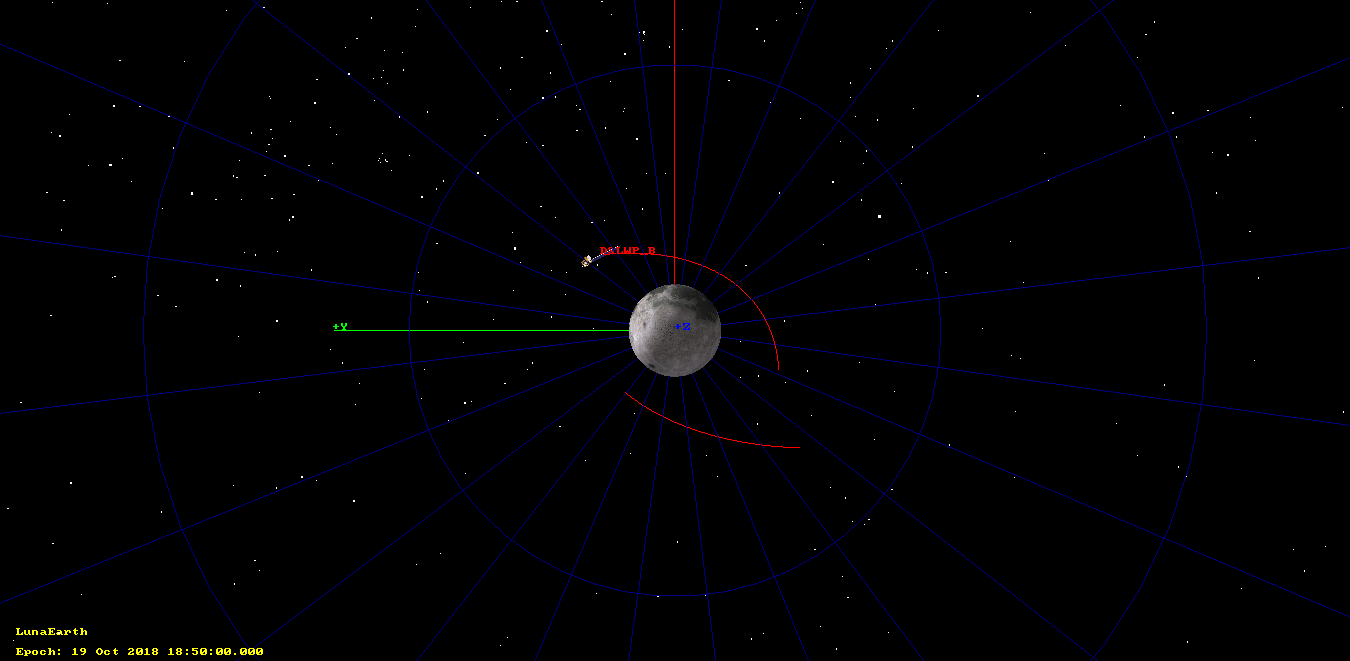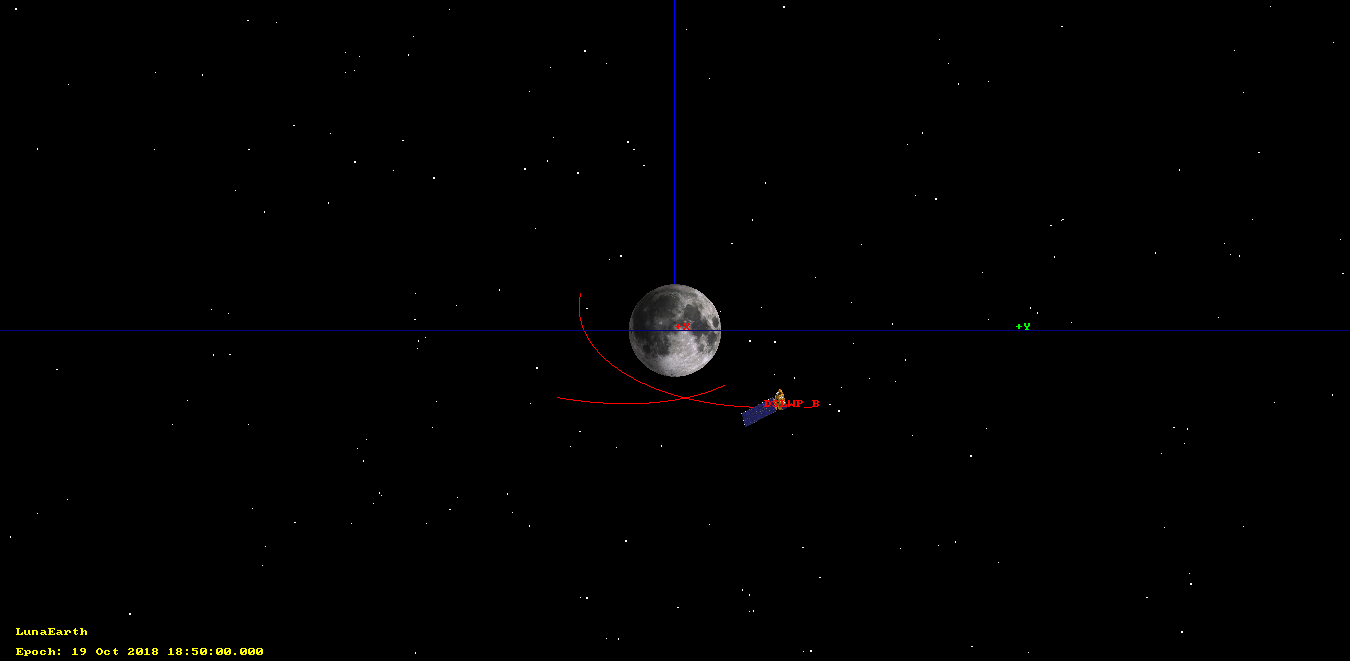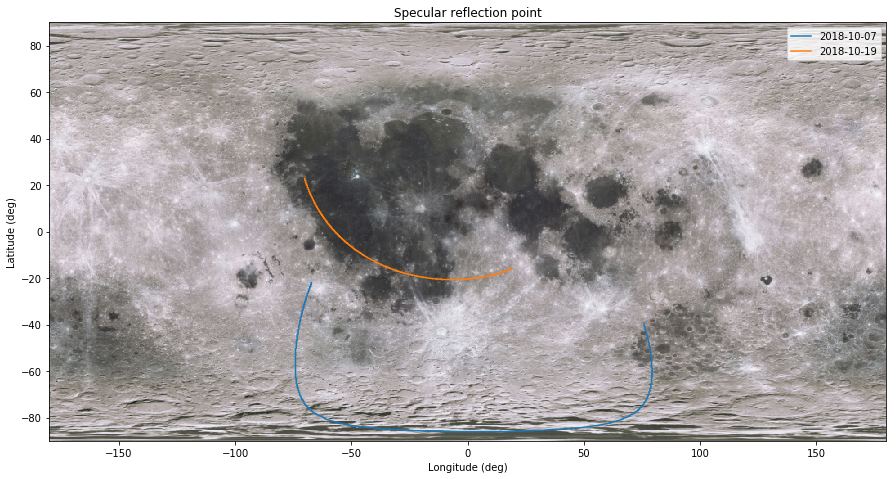I have already spoken about the Moonbounce signal from DSLWP-B in several posts. To sum up, DSLWP-B is a Chinese satellite that is orbiting the Moon since May 25. The satellite has an Amateur payload that transmits GMSK and JT4G telemetry in the 70cm Amateur satellite band. This signal can be received by well equipped groundstations on Earth, including the 25m radiotelescope at Dwingeloo, in the Netherlands (and also by much smaller stations).
The people at Dwingeloo publish the recordings that they make of the RF signal. In two of these recordings, the signal from DSLWP-B is received not only via the direct path, but also through a reflection off the Moon’s surface. The reflected signal is around 25dB weaker, usually has a different Doppler shift, and has a Doppler spread of around 50 to 200Hz.
What I find most interesting about this is that of all the days that Dwingeloo has observed DSLWP-B, in only two of them (on 2018-10-07 and 2018-10-19) the Moonbounce signal has been visible. Mathematically, using a specular reflection on a sphere model, whenever the satellite is visible directly, there is also a ray from the spacecraft that reflects off the lunar surface and arrives at the groundstation (see the proof here). Therefore, I think that there must be something about the particular geometry of the days 7th and 19th that made the Moon reflections relatively stronger and hence detectable. Here I use GMAT to study the orbital geometry when the reflections were received.
The GMAT script I have used for the simulations can be found here. The lunar reflections were found in the observing sessions on 2018-10-07 10:00 to 12:00 UTC and 2018-10-19 16:50 to 18:50 UTC. The script plots the orbit of DSLWP-B around the Moon for these two observing sessions.
In the reference frame chosen, the +X axis points towards the Earth, the +Z axis is perpendicular to the Moon’s orbital plane, pointing north, and the +Y axis completes a right-handed system of reference. Therefore, although the Earth doesn’t appear in the images below (to give an adequate scale), the direction towards the Earth is the red line marking the +X axis.
In the figures below we see the two orbits corresponding to the observing sessions on the 7th and the 19th. One of the images shows a view from the top and the other image shows the view from Earth. On the first image, the orbit of the 7th corresponds to the orbit “behind” the Moon, towards the bottom of the image. The orbit of the 19th corresponds to the orbit “in front” of the Moon, towards the top of the image. The orbit direction is counter-clockwise, as seen in the top view.


We see that the geometry for each of the two situations is quite different. On the 7th, the satellite was “behind” the Moon, and the reflection happened near the lunar south pole. The reflection happened in a “forward scatter” fashion. In contrast, on the 19th the satellite was between the Earth and the Moon. The reflection happened near the centre of the near side of the Moon, in a “backscatter” fashion. The reflection angles in these two cases were very different also.
The figure below shows the points of the lunar surface where a specular reflection would happen, for each of the two observing sessions. This illustrates the differences described above.

Another difference between the two observations was the Doppler spread. I have not made precise measurements but it seems that the Doppler spread on the 7th was around 50Hz, while on the 19th it was between 100Hz to 200Hz. This might indicate that the area of the lunar surface where the reflection happened was smaller on the 7th than on the 19th.
Given that these two geometric situations are very different, I am surprised by the fact that these two observing sessions produced detectable Moonbounce signals, while the others did not. I still have no clue about which geometric conditions on the reflection might favour relatively stronger reflections.
It is also important to remark that there is a certain bias in detecting lunar reflections. We can only detect the reflection when the Doppler of the reflected signal and the direct signal differ by more than a few hundreds of Hz. When the Dopplers are very similar, the direct signal interferes with the reflected signal and we cannot determine if a reflection is being received (especially for the GMSK signal, which is wider than the JT4G tones). However, I expect that most of the time the Dopplers of the reflected and direct signal are quite different.
Another bias which might be more important is that the beamwidth of the the 25m dish at Dwingeloo is rather narrow (a couple of degrees). During the observations, the dish points to DSLWP-B, so depending on the separation of DSLWP-B and the Moon, the gain of the dish in the direction of the Moon (which is where the reflected signal comes from) might be much lower. This makes it more likely to detect Moonbounce signals when DSLWP-B is closer to the Moon, as seen from Earth.
The plot of the specular reflection point has been made in this Jupyter notebook.
Hola Daniel.
Me dirijo a ti para preguntarte si hay alguna manera sencilla de calcular el doppler para recibir este satélite. Aunque mi instalación es muy sencilla, creo que podría recibirlo.
Pero en las capturas que ponen los colegas en el twitter veo que hay diferentes frecuencias y diferencias debido al doppler.
Por cierto que es mejor: 435.400 ó 436.400 MHz ?
Gracias por anticipado. Saludos de Carlos
Hola Carlos,
El Doppler se puede calcular con el bloque Program Tracking CC de gr-dslwp o con GMAT (hay información sobre GMAT en algunos de mis posts).
Los transmisores en 435.4 y 436.4 utilizan antenas distintas, por lo que dependiendo de la geometría, la señal en una frecuencia puede ser más fuerte que en la otra. También tienes que tener en consideración el modo que quieras recibir. Últimamente 435.4 se está utilizando para la baliza GMSK y la baliza JT4G y 436.4 para la baliza GMSK y SSDV.
El GMAT me lo instalé, pero una versión mas antigua (el más nuevo no tira con mi pc), pero no supe hacerlo ir, por más que leí y releí (debo de ser “mu” torpe).
Y perdona mi ignorancia , que es el bloque Program Traking CC de gr-dslpw? Es una aplicación o un programa? Donde lo encuentro y donde hay info sobre cono se usa?
De nuevo, gracias por tu tiempo.
Saludos de Carlos
https://github.com/bg2bhc/gr-dslwp
https://github.com/bg2bhc/gr-dslwp/blob/master/lib/program_tracking_cc_impl.cc
Hola. Entiendo que los enlaces que me has puesto son para hacerlo funcionar en Linux. He mirado un poco y he visto que hay algo que se puede compilar para win 7 y hacia arriba (¿es así?)
Lastima aun voy con win xp (y me va muy bien por cierto).
He visto también que había una distro para un Linux Live CD, pero me da error, me dice que ya no esta o no tengo permiso para verlo, el caso es que a lo mejor esto si que podría funcionar en mi pc, ¿sabes si hay alguna forma fácil (es decir para tontos) de usar estos programas?
De nuevo muchas gracias por tu ayuda y se paciente conmigo.
73 de Carlos
Aunque en principio no tiene por qué ser imposible compilar gr-dslwp en Windows, mi recomendación es que lo hagas en Linux. Puedes intentar probar suerte con el Live CD de GNU Radio, aunque a la larga probablemente es mejor que instales una distribución de uso general.